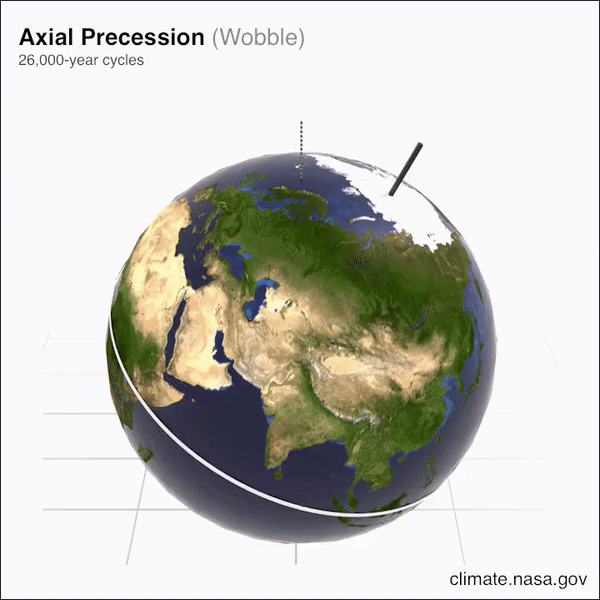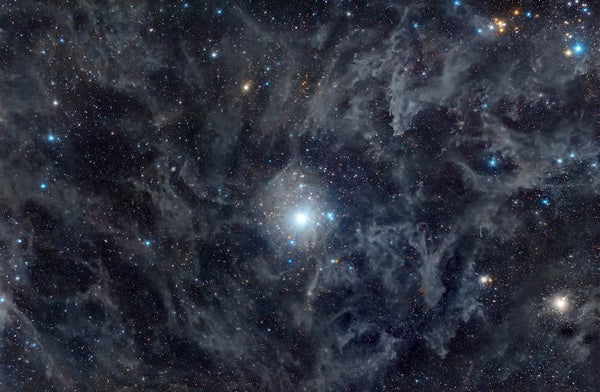Our Earth is wobbling!
You wouldn’t personally notice it, though. While the wobble is pretty big, it takes a long time to play out. Over a human lifetime, the effect is so small as to be unnoticeable.
But over humanity’s lifetime, the effect has been not only noticeable but profound. Earth’s wobble has affected climate, navigation and our calendar. It’s even had an impact on pop music.
On supporting science journalism
If you're enjoying this article, consider supporting our award-winning journalism by subscribing. By purchasing a subscription you are helping to ensure the future of impactful stories about the discoveries and ideas shaping our world today.
You’re already familiar with the two major motions Earth makes in and through space. One is its diurnal rotation, the daily spin it makes around its axis, like a basketball twirling on top of a grandstanding player’s finger. The other motion is Earth’s annual revolution around the sun, the time it takes to orbit once: our year.
These have obvious effects on our daily life—it’s right there in the adjective—as well as during our lifetime. But there is a third motion that Earth makes that is called precession. And you’ve likely seen it before but on a far smaller scale.
If you spin a toy top on a flat surface, its axis of rotation will be very nearly vertical. But after a moment, the top will start to slowly wobble, and the axis itself will make a slow circle around the vertical, drawing out a virtual cone in space.
The top does this because its spin is not perfectly vertical. The rotation axis tilts just a little bit, and gravity tries to pull the spinning top down. The top can’t fall over, though, because it’s spinning rapidly, creating a gyroscopic effect. The detailed physics is complicated (I wish I had a dollar for every time I had to say that), but the overall action pushes the top sideways, creating the slow precessional motion. The key factor here is torque, a force on the spinning object that changes the direction of spin, which in this case is caused by gravity.
Like a top, Earth spins as well, once per day. That spin defines its geographic poles, both North and South. Draw a line between them, and you get Earth’s rotational axis. In fact, if you extend this imaginary axis into space, it points to two spots on the sky called the celestial poles. If you were standing exactly on Earth’s North Pole, the north celestial pole would be exactly overhead.
If it were left to its own devices, Earth’s axis would always point in the same direction in space. If only things were so simple!
As Earth spins, centrifugal force makes Earth’s equator bulge—so it’s not a perfect sphere but instead a flattened one, like a beach ball that someone is sitting on. Also, Earth’s axis isn’t vertical relative to its orbit around the sun but is instead tipped by about 23.5 degrees.
The sun’s gravity pulls on that misaligned bulge, creating a torque by trying to get the bulge to align with the plane of Earth’s orbit. The moon orbits Earth in a plane tipped toward the bulge, so the moon’s gravity yanks on the bulge as well. As a consequence, the direction of Earth’s axis slowly wobbles in space, making a complete circle once every 26,000 years or so. That circle is 47 degrees across (twice the 23.5 degree angle of Earth’s axial tilt), centered on the point in the sky 90 degrees from the plane of its orbit.

This visualization shows Earth’s axial precession, a wobble in the planet’s rotational axis with a period of about 26,000 years that is induced by tidal forces from the sun and moon. Credit: NASA/JPL-Caltech
At this moment in history, the north celestial pole is very near the somewhat bright star Polaris—note the name—which marks the tip of the tail of the constellation Ursa Minor (the Little Bear, commonly called the Little Dipper). If you can see Polaris, you can orient yourself to Earth’s North Pole, and this fact has been used for celestial navigation for centuries. There’s no real equivalent in the Southern Hemisphere. The closest celestial object to the south celestial pole is Sigma Octantis, a star that is barely visible to the naked eye, which makes it less than ideal for navigation.
But thanks to precession, such alignments are a matter of coincidence. The north celestial pole moves relative to the stars, so Polaris’s time on the boreal throne is temporary. It’s currently a little less than a degree from the true pole, and will be at its closest around the year 2100, when it will be approximately 0.5 degree away.
This means Polaris wasn’t always the pole star and only reached that status a few centuries ago. Before it, the star Kochab, one of the “bowl” stars in the Little Dipper, was the pole star, and before that it was Alpha Draconis, also called Thuban, back in 2500 B.C.E., around the time the Egyptian pyramids were being built.
I hate to be that guy, but this means that Shakespeare blew it in his play Julius Caesar. In it, Caesar says, “But I am constant as the northern star, of whose true-fix’d and resting quality there is no fellow in the firmament.” Yeah, oops. Not only has the North Star not always been the North Star, but other stars have been it, too. And the North Star when Shakespeare wrote the play wasn’t the same star as when Caesar was actually alive!
Although only incidental to the Bard’s canon, Earth’s precession is actually crucial to astronomers. We use a coordinate system on the sky that is very much like longitude and latitude. It’s fixed to Earth’s actual axis and also, therefore, to the celestial poles. But the poles move relative to the stars because of precession! The change is small, but when you’re pointing a telescope, you have to account for it, or you might miss your target. The effect gets worse over time, so astronomers have to periodically update their entire mapping system, which, to put it mildly, is a pain.
A much more important effect of precession is on climate. Right now the North Pole points toward the sun in June, at the solstice. This is also when Earth is farthest from the sun, a time called aphelion. Because of precession, though, about 10,000 years ago the North Pole was tipped toward the sun at perihelion, when the sun and Earth are closest. This made summers in the Northern Hemisphere a bit hotter, which has been shown to affect the amount of humidity in northern Africa; it may be tied to the desertification and regreening of the Sahara on a roughly 10,000-year cycle.
This also affects the timing of the seasons. The moment of the March equinox, for example, is measured using the position of the sun at a specific point in the sky. Precession moves that point slightly every year, and, across centuries, this moves the dates of the equinoxes and solstices by weeks and months. To account for this, astronomers use what’s called a tropical year, which is measured equinox to equinox; otherwise northern winter would eventually occur in June.
There is a related effect, one that I’m hesitant to bring up. If you’re an astrology buff, you may want to skip reading this part.
The current zodiac constellations were established thousands of years ago. At that time, for example, the vernal equinox, in late March, occurred when the sun was in Aries. Precession has moved the constellations, however, so that the sun is now in Pisces at that time, which throws off the dates that astrologers assign to the constellations. If you’re an Aries and think that being born under the sign of the ram has given you certain characteristics, I have news for you: you’re actually a Pisces.
In the next few centuries, that point in the sky will move into the constellation Aquarius, hence the dawning of the Age of Aquarius—which made for a great song by the 5th Dimension (it spent six weeks at number one on the Billboard Hot 100 chart in 1969) but is probably not the best basis for making life choices.
If you’re going to dedicate yourself to the stars, may I suggest astronomy instead? It’s how we learned what the day and year are, after all, and how we found out about precession as well. But only dive into the field if you’re so inclined.
